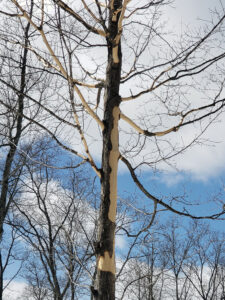By Linda Williams, DNR Forest Health Specialist, Woodruff;
Linda.Williams@wisconsin.gov or 920-360-0665

Squirrels have stripped off the bark of this maple tree to get at the sweet cambium layer under the bark. / Photo Credit: Linda Williams, Wisconsin DNR
Typically in the spring, squirrels can cause damage to maple trees by removing bark from branches and the main stem after the trees have been frozen all winter and the weather starts to warm up. This fall, before the January cold spell, temperatures had warmed up by mid-November and remained warm throughout December.
As a result, starting in late November fresh squirrel damage was being noted on some scattered maples in north central Wisconsin. Damage progressed throughout December and some trees have more than half of the bark removed from branches and the main stem. The sight of scattered bits of bark around the base of these trees is another sign of squirrel activity.
Grey squirrels are the primary culprit. The squirrels are going after the cambium layer, just under the bark, that tastes slightly sweet from the sugary sap. Smooth bark is easier for squirrels to chew, so young trees or branches with thinner bark are more likely to be stripped than those with older, furrowed bark. With the arrival of cold weather, the squirrels may stop stripping the trees of their bark but may resume when temperatures warm in the spring and sap starts to flow again.
Damaged branches may try to leaf out in the spring with what little sugar reserves were stored in the buds, but the leaves will quickly die because the tree can’t move water and sugars out to the branches beyond spots that were completely girdled.
Branches that are partially girdled may leaf out in the spring and grow leaves as normal until a hot day occurs. Then, because of the partial girdling, the tree can’t move enough water to support the leaves and the branch dies quickly in the middle of the growing season.
Many of these branches and trees will not survive this severe amount of debarking. Reducing the squirrel population or preventing them from climbing your trees are options for controlling this damage, although both are difficult.
